engine TOYOTA SEQUOIA 2020 (in English) User Guide
[x] Cancel search | Manufacturer: TOYOTA, Model Year: 2020, Model line: SEQUOIA, Model: TOYOTA SEQUOIA 2020Pages: 56, PDF Size: 5.2 MB
Page 27 of 56
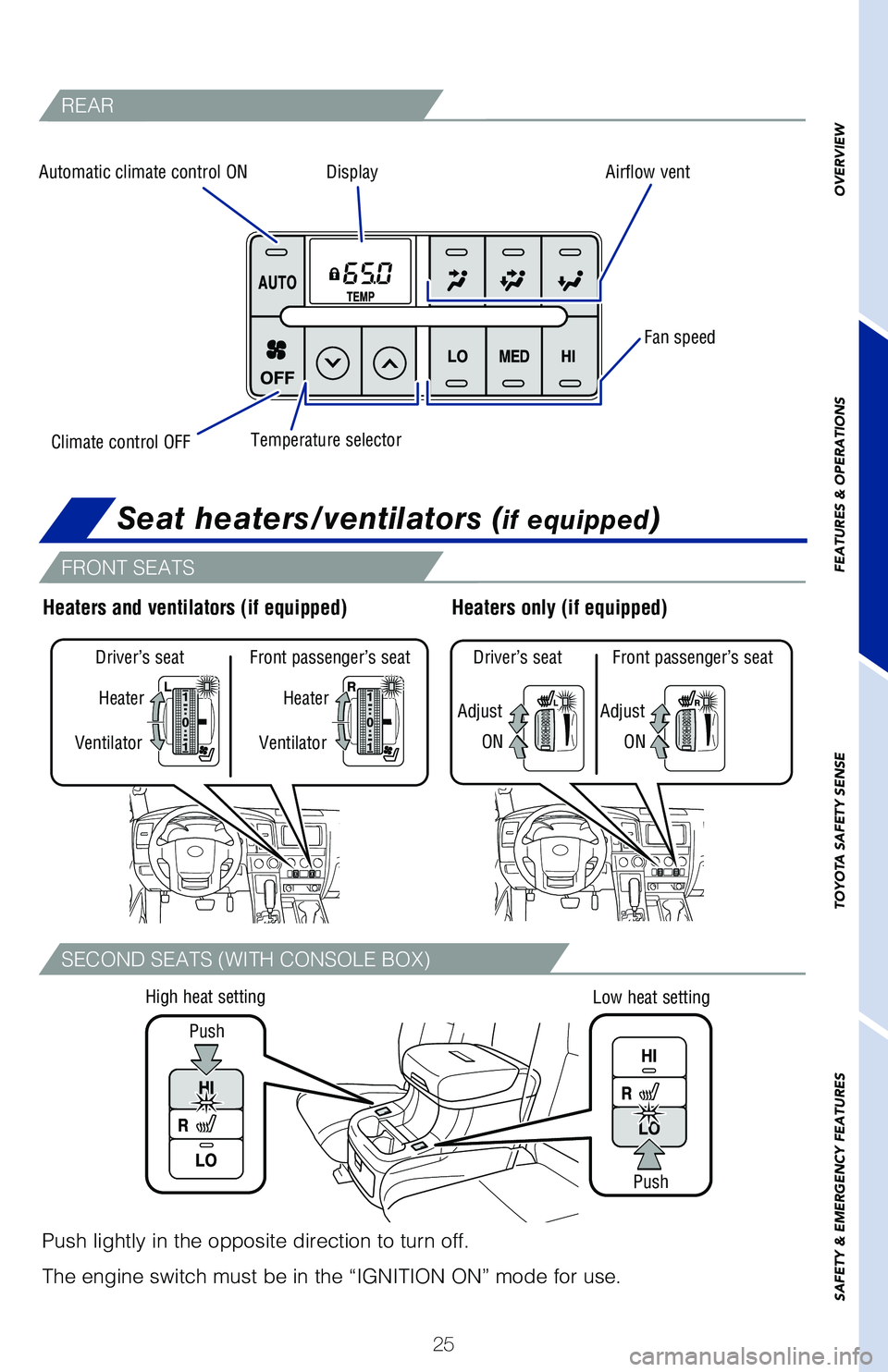
25
OVERVIEW
FEATURES & OPERATIONS
TOYOTA SAFETY SENSE
SAFETY & EMERGENCY FEATURES
REAR
FRONT SEATS
SECOND SEATS (WITH CONSOLE BOX)
Climate control OFF
Driver’s seat Front passenger’s seat
Ventilator
Ventilator Heater
Heater
Adjust
Driver’s seat Front passenger’s seat
ON
Adjust
ON
Heaters only (if equipped)Heaters and ventilators (if equipped)
Push
Push
Low heat setting
High heat setting
Push lightly in the opposite direction to turn off.
The engine switch must be in the “IGNITION ON” mode for use.
Automatic climate control ON
DisplayAirflow vent
Fan speed
Temperature selector
Seat heaters/ventilators (if equipped)
Page 28 of 56
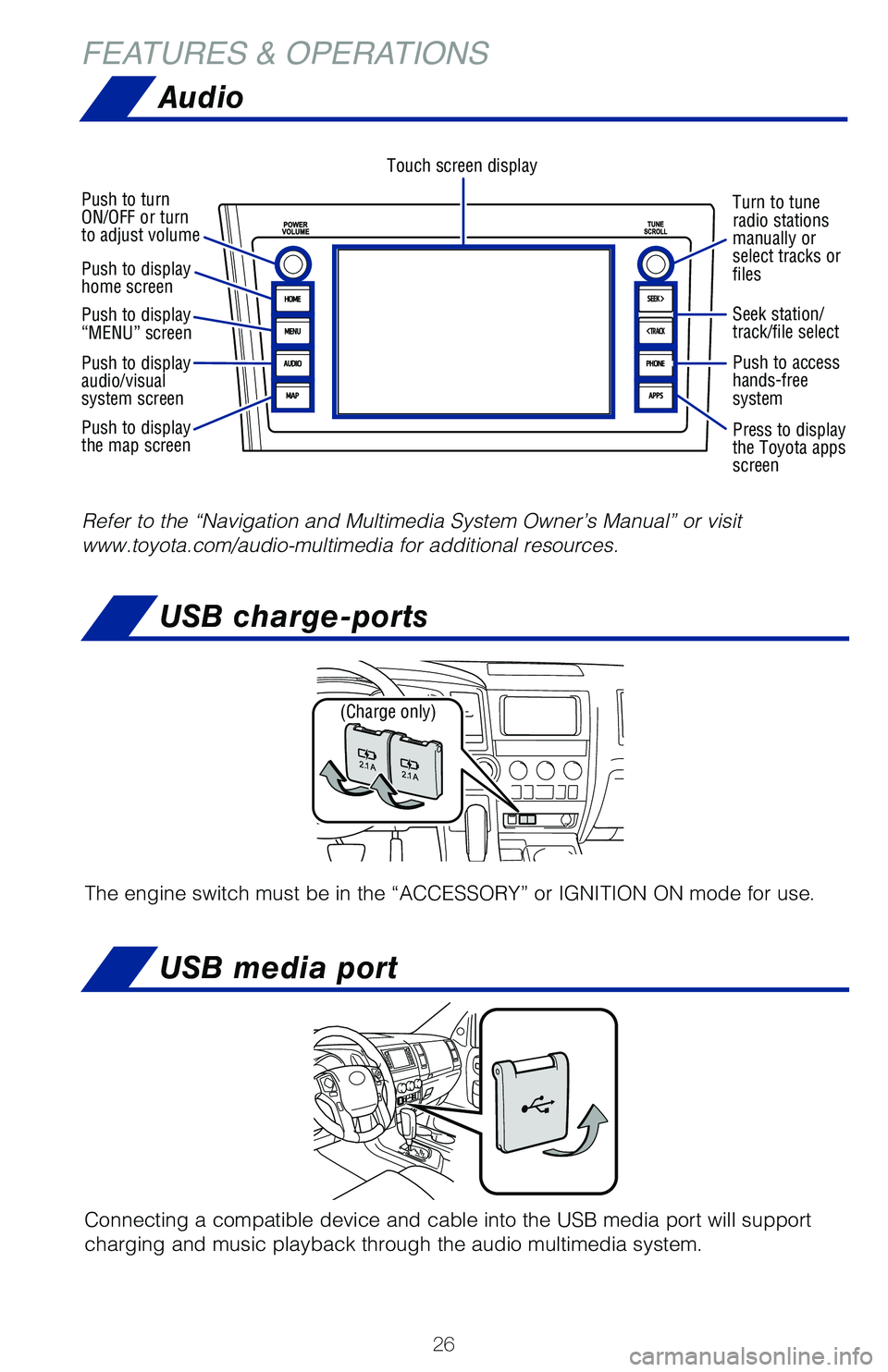
26
FEATURES & OPERATIONS
Turn to tune
radio stations
manually or
select tracks or
files
Touch screen display
Push to turn
ON/OFF or turn
to adjust volume
Push to display
home screen
Push to display
“MENU” screen
Push to display
audio/visual
system screen
Push to display
the map screen
USB media port
USB charge-ports
Connecting a compatible device and cable into the USB media port will su\
pport
charging and music playback through the audio multimedia system.
Refer to the “Navigation and Multimedia System Owner’s Manual” \
or visit
www.toyota.com/audio-multimedia for additional resources.
Seek station/
track/file select
Push to access
hands-free
system
Press to display
the Toyota apps
screen
(Charge only)
The engine switch must be in the “ACCESSORY” or IGNITION ON mode f\
or use.
Audio
Page 29 of 56
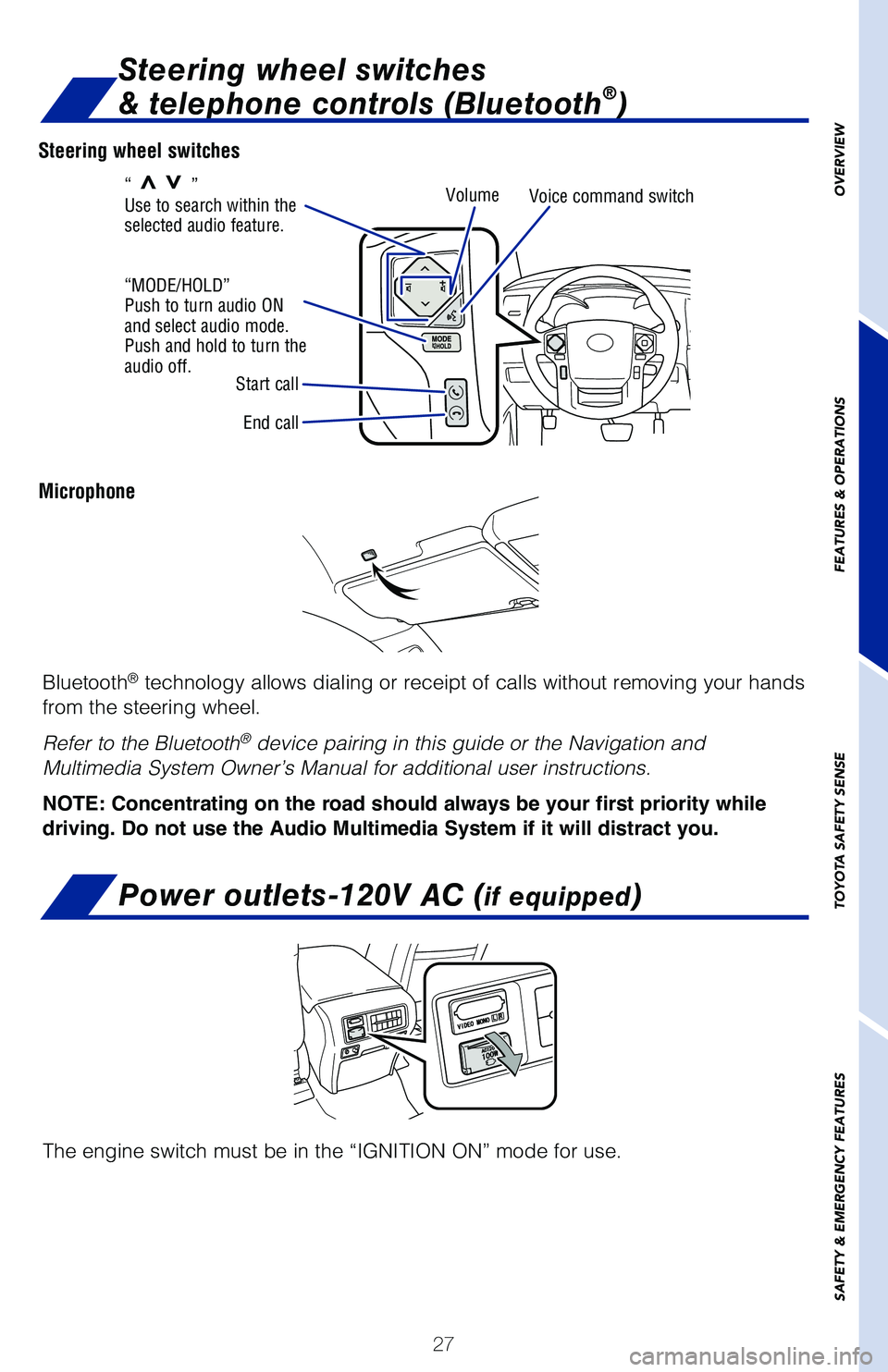
27
OVERVIEW
FEATURES & OPERATIONS
TOYOTA SAFETY SENSE
SAFETY & EMERGENCY FEATURES
Steering wheel switches
Microphone
End call Volume
Voice command switch
Start call
“MODE/HOLD”
Push to turn audio ON
and select audio mode.
Push and hold to turn the
audio off. “
>>”
Use to search within the
selected audio feature.
Steering wheel switches
& telephone controls (Bluetooth®)
Bluetooth® technology allows dialing or receipt of calls without removing your han\
ds
from the steering wheel.
Refer to the Bluetooth
® device pairing in this guide or the Navigation and
Multimedia System Owner’s Manual for additional user instructions.
NOTE: Concentrating on the road should always be your first priority while
driving. Do not use the Audio Multimedia System if it will distract you.
The engine switch must be in the “IGNITION ON” mode for use.
Power outlets-120V AC (if equipped)
Page 30 of 56

28
FEATURES & OPERATIONSPower outlets-12V DC
Luggage compartment
Instrument panelInside of the center console box
Back of the center console box (if equipped)
The engine switch must be in the “ACCESSORY” or “IGNITION ON”\
mode for use.
Rear seat entertainment system (if equipped)
For details, refer to the Navigation and Multimedia System Owner’s Ma\
nual.
Front audio/visual system DVD player
DVD screen
Remote control
A/V input port
120V AC power outlet Headphone volume controls
and headphone jacks
Page 34 of 56
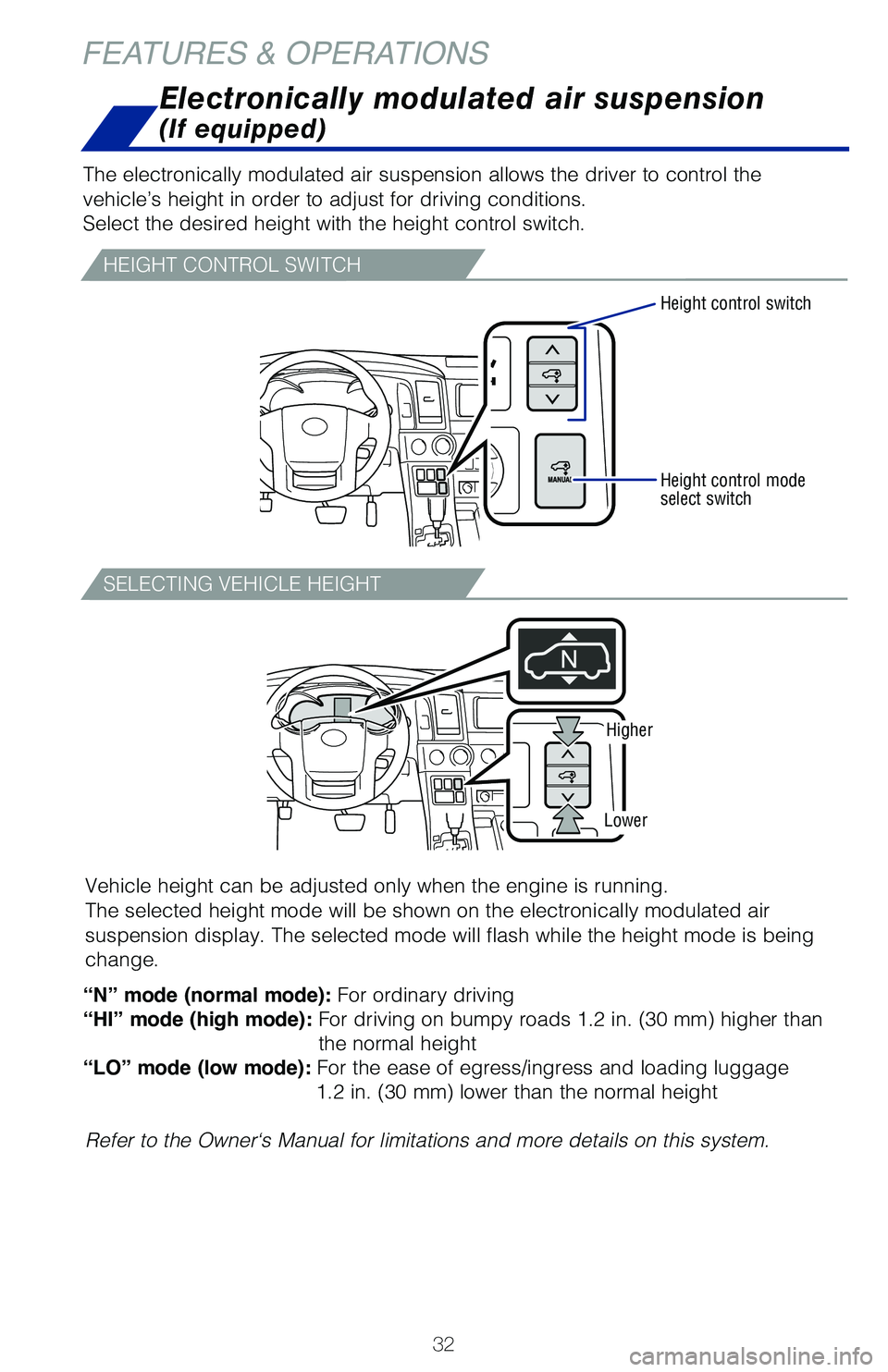
32
Electronically modulated air suspension
(If equipped)
FEATURES & OPERATIONS
The electronically modulated air suspension allows the driver to control\
the
vehicle’s height in order to adjust for driving conditions.
Select the desired height with the height control switch.
“N” mode (normal mode): For ordinary driving
“HI” mode (high mode): For driving on bumpy roads 1.2 in. (30 mm) higher than
the normal height
“LO” mode (low mode): For the ease of egress/ingress and loading luggage
1.2 in. (30 mm) lower than the normal height
Vehicle height can be adjusted only when the engine is running.
The selected height mode will be shown on the electronically modulated a\
ir
suspension display. The selected mode will flash while the height mode i\
s being
change.
Refer to the Owner‘s Manual for limitations and more details on this system.
HEIGHT CONTROL SWITCH
SELECTING VEHICLE HEIGHT
Height control switch
Higher
Lower
Height control mode
select switch
Page 38 of 56
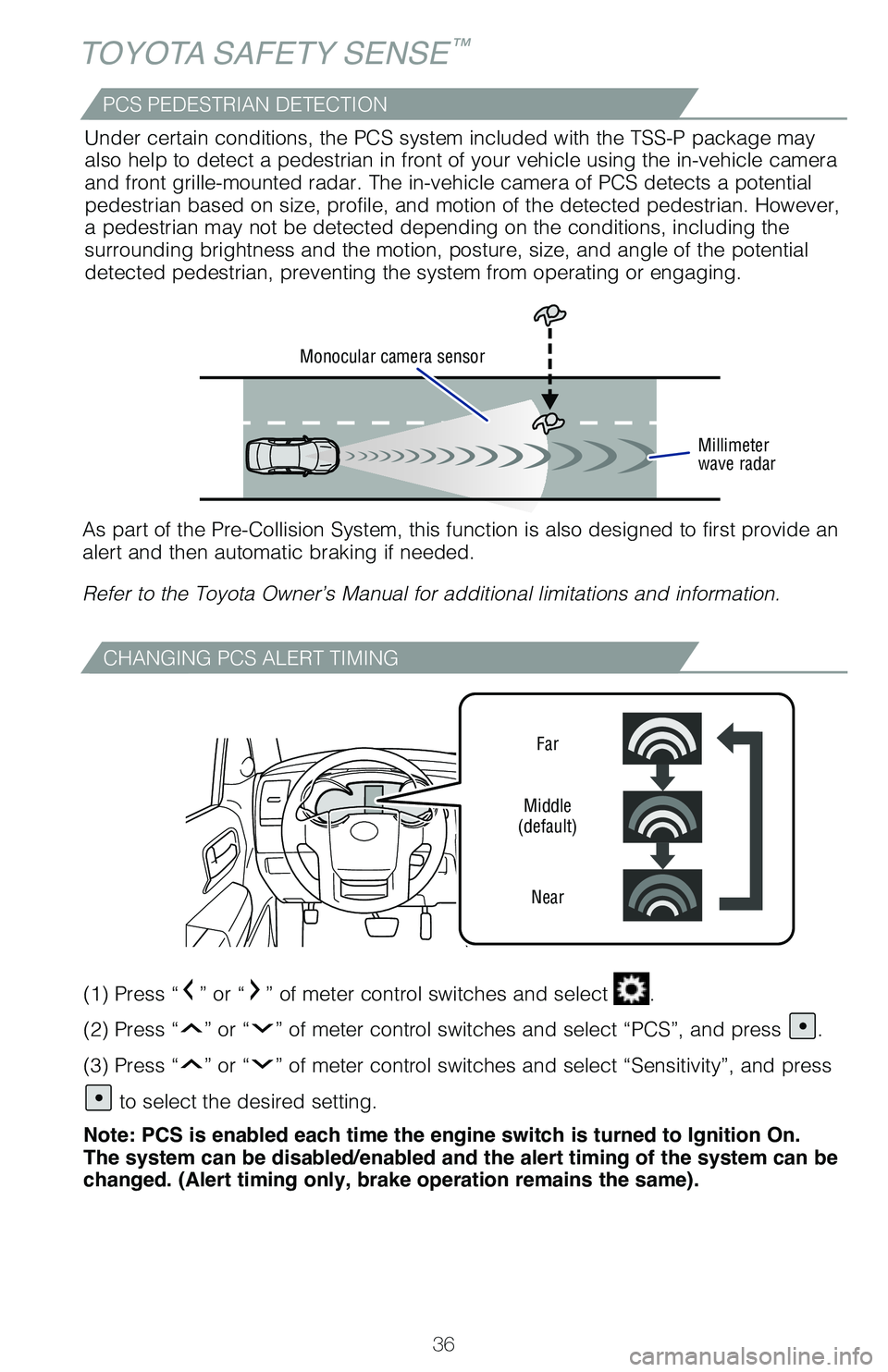
36
TOYOTA SAFETY SENSE™
CHANGING PCS ALERT TIMING
Far
Middle
(default)
Near
(1) Press “” or “” of meter control switches and select .
(2) Press “
” or “” of meter control switches and select “PCS”, and press .
(3) Press “
” or “” of meter control switches and select “Sensitivity”, and press\
to select the desired setting.
Note: PCS is enabled each time the engine switch is turned to Ignition On.
The system can be disabled/enabled and the alert timing of the system can be
changed. (Alert timing only, brake operation remains the same).
Monocular camera sensor
Millimeter
wave radar
As part of the Pre-Collision System, this function is also designed to f\
irst provide an
alert and then automatic braking if needed.
Refer to the Toyota Owner’s Manual for additional limitations and inf\
ormation.Under certain conditions, the PCS system included with the TSS-P package\
may
also help to detect a pedestrian in front of your vehicle using the in-v\
ehicle camera
and front grille-mounted radar. The in-vehicle camera of PCS detects a p\
otential
pedestrian based on size, profile, and motion of the detected pedestrian\
. However,
a pedestrian may not be detected depending on the conditions, including \
the
surrounding brightness and the motion, posture, size, and angle of the p\
otential
detected pedestrian, preventing the system from operating or engaging.
PCS PEDESTRIAN DETECTION
Page 40 of 56
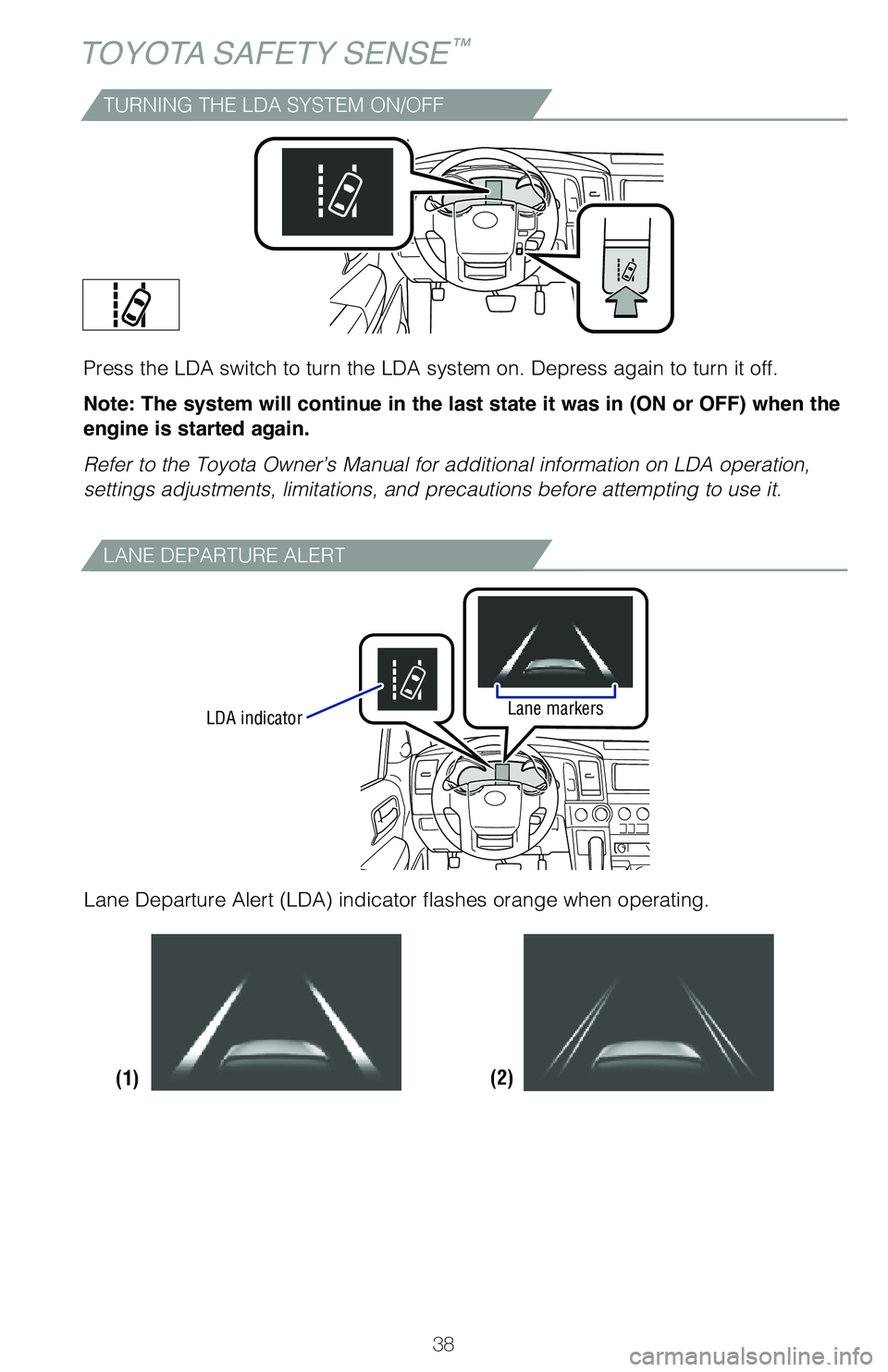
38
TOYOTA SAFETY SENSE™
LDA indicatorLane markers
(2)
(1)
LANE DEPARTURE ALERT
Lane Departure Alert (LDA) indicator flashes orange when operating.
TURNING THE LDA SYSTEM ON/OFF
Press the LDA switch to turn the LDA system on. Depress again to turn it\
off.
Note: The system will continue in the last state it was in (ON or OFF) when the
engine is started again.
Refer to the Toyota Owner’s Manual for additional information on LDA \
operation,
settings adjustments, limitations, and precautions before attempting to \
use it.
Page 45 of 56
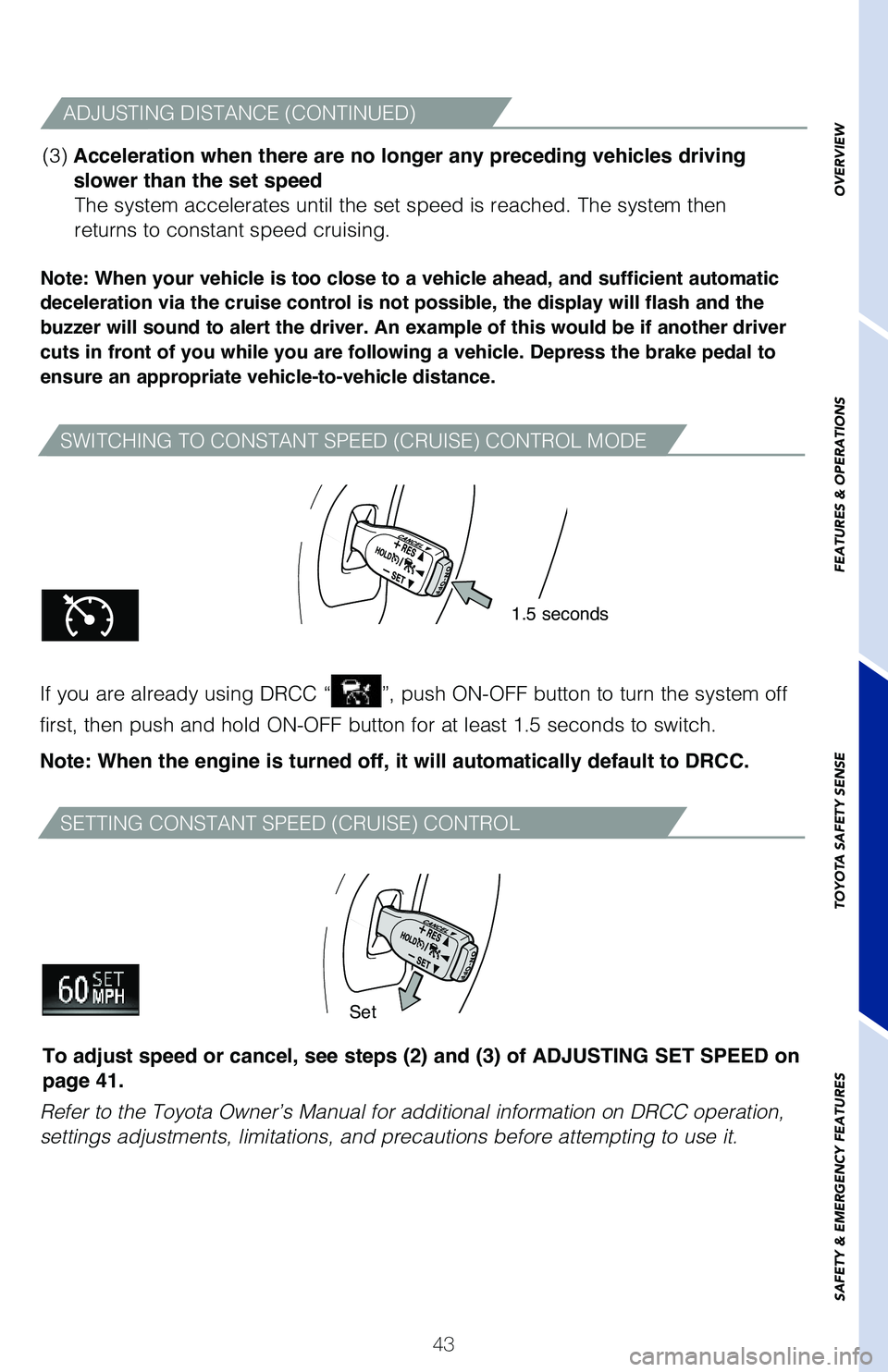
43
OVERVIEW
FEATURES & OPERATIONS
TOYOTA SAFETY SENSE
SAFETY & EMERGENCY FEATURES
SWITCHING TO CONSTANT SPEED (CRUISE) CONTROL MODE
SETTING CONSTANT SPEED (CRUISE) CONTROL
Note: When your vehicle is too close to a vehicle ahead, and sufficient automatic
deceleration via the cruise control is not possible, the display will flash and the
buzzer will sound to alert the driver. An example of this would be if another driver
cuts in front of you while you are following a vehicle. Depress the brake pedal to
ensure an appropriate vehicle-to-vehicle distance.
If you are already using DRCC “”, push ON-OFF button to turn the system off
first, then push and hold ON-OFF button for at least 1.5 seconds to swit\
ch.
Note: When the engine is turned off, it will automatically default to DRCC.
Refer to the Toyota Owner’s Manual for additional information on DRCC\
operation,
settings adjustments, limitations, and precautions before attempting to \
use it.
1.5 seconds
Set
(3) Acceleration when there are no longer any preceding vehicles driving
slower than the set speed The system accelerates until the set speed is reached. The system then
returns to constant speed cruising.
To adjust speed or cancel, see steps (2) and (3) of ADJUSTING SET SPEED on
page 41.
ADJUSTING DISTANCE (CONTINUED)
Page 46 of 56
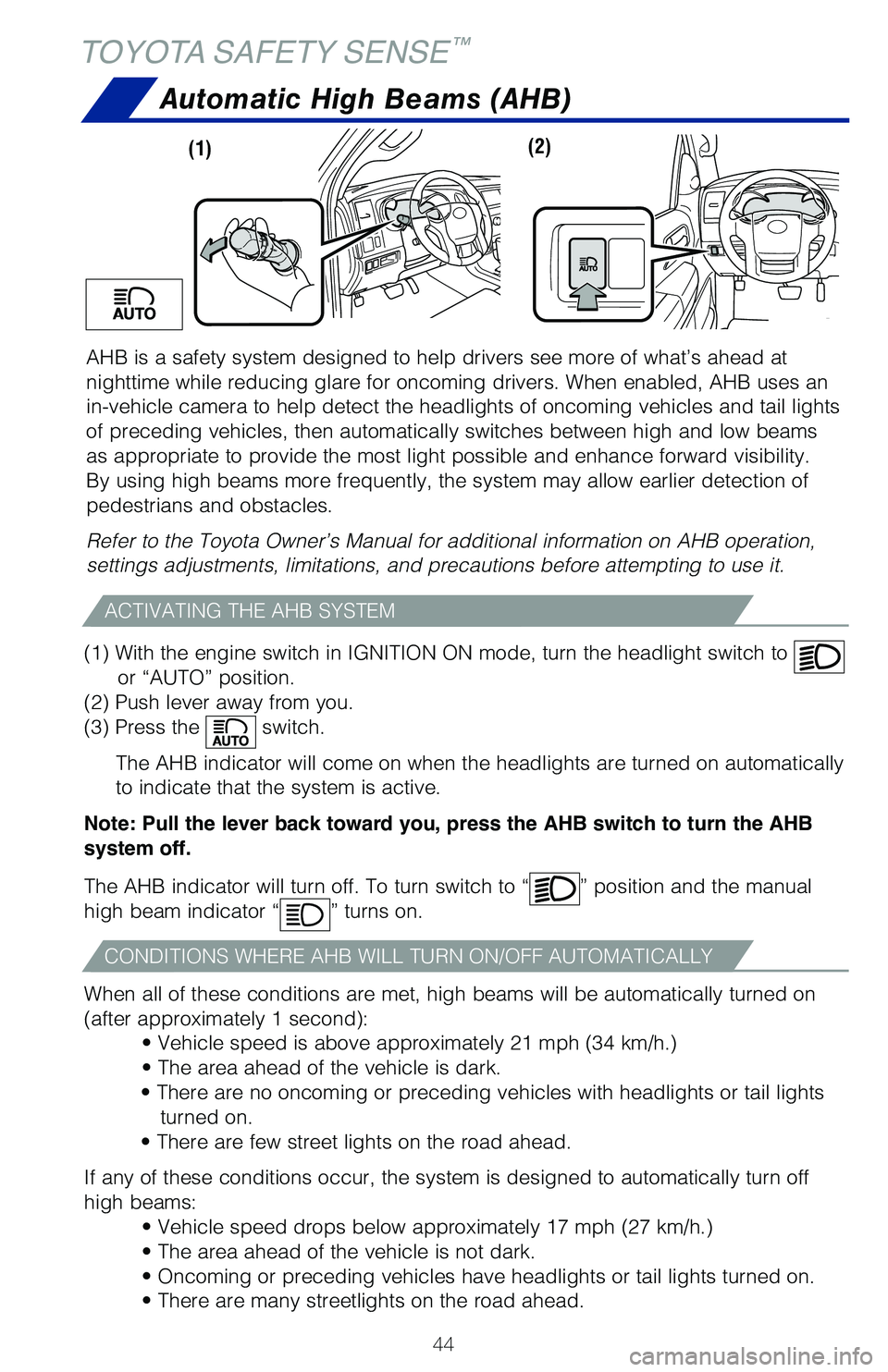
44
TOYOTA SAFETY SENSE™
AHB is a safety system designed to help drivers see more of what’s ah\
ead at
nighttime while reducing glare for oncoming drivers. When enabled, AHB u\
ses an
in-vehicle camera to help detect the headlights of oncoming vehicles and\
tail lights
of preceding vehicles, then automatically switches between high and low \
beams
as appropriate to provide the most light possible and enhance forward vi\
sibility.
By using high beams more frequently, the system may allow earlier detect\
ion of
pedestrians and obstacles.
Refer to the Toyota Owner’s Manual for additional information on AHB \
operation,
settings adjustments, limitations, and precautions before attempting to \
use it.
Automatic High Beams (AHB)
(1) With the engine switch in IGNITION ON mode, turn the headlight swi\
tch to
or “AUTO” position.
(2) Push lever away from you.
(3) Press the
switch.
The AHB indicator will come on when the headlights are turned on automat\
ically
to indicate that the system is active.
Note: Pull the lever back toward you, press the AHB switch to turn the AHB
system off.
The AHB indicator will turn off. To turn switch to “
” position and the manual
high beam indicator “
” turns on.
When all of these conditions are met, high beams will be automatically t\
urned on
(after approximately 1 second): • Vehicle speed is above approximately 21 mph (34 km/h.)
• The area ahead of the vehicle is dark.
• There are no oncoming or preceding vehicles with headlights or tail lights turned on.
• There are few street lights on the road ahead.
If any of these conditions occur, the system is designed to automaticall\
y turn off
high beams: • Vehicle speed drops below approximately 17 mph (27 km/h.)
• The area ahead of the vehicle is not dark.
• Oncoming or preceding vehicles have headlights or tail lights turned on.
• There are many streetlights on the road ahead.
ACTIVATING THE AHB SYSTEM
CONDITIONS WHERE AHB WILL TURN ON/OFF AUTOMATICALLY
(1) (2)
Page 50 of 56
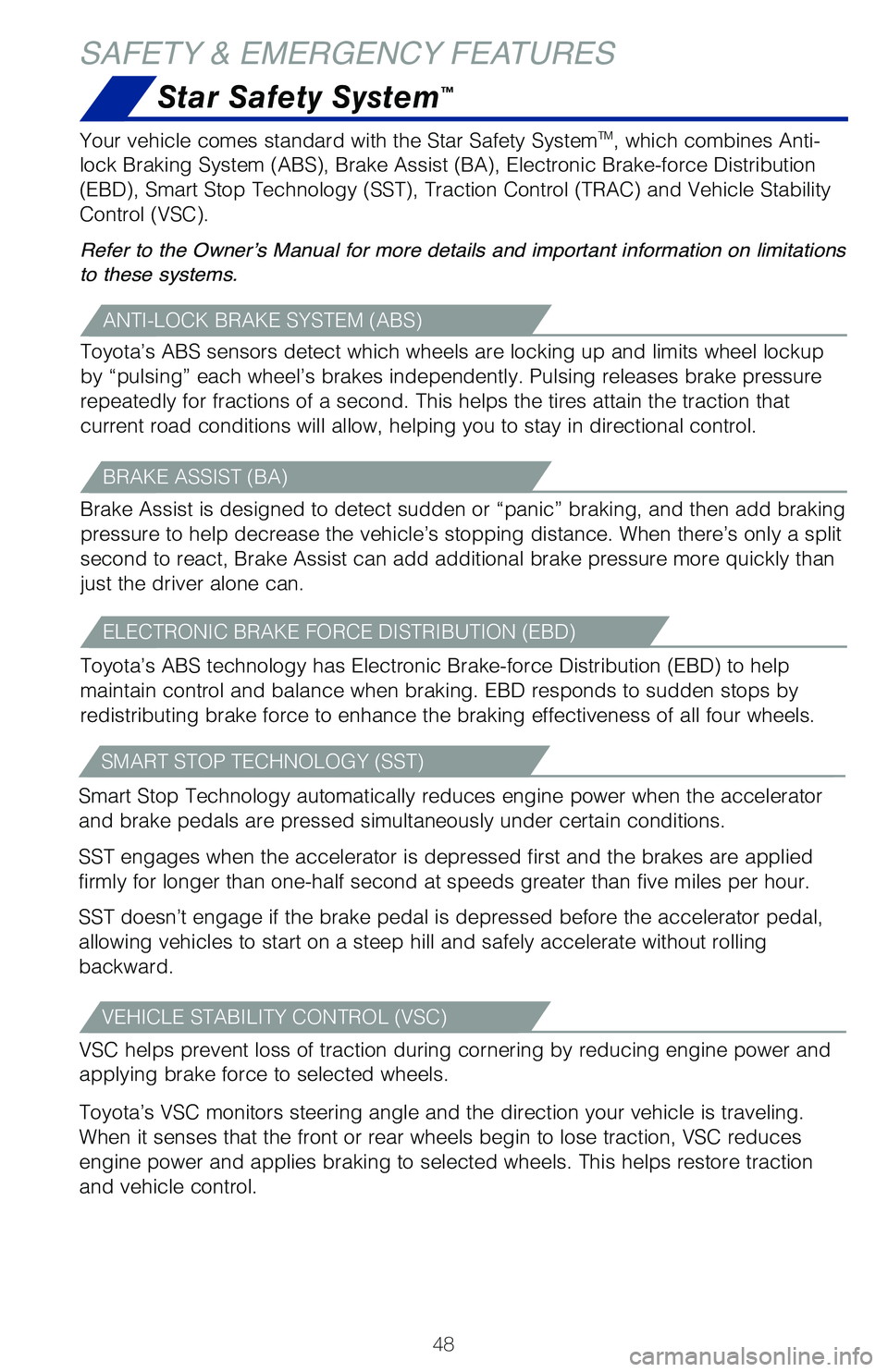
48
Star Safety System™
Your vehicle comes standard with the Star Safety SystemTM, which combines Anti-
lock Braking System (ABS), Brake Assist (BA), Electronic Brake-force\
Distribution
(EBD), Smart Stop Technology (SST), Traction Control (TRAC) and Ve\
hicle Stability
Control (VSC).
Refer to the Owner’s Manual for more details and important information on limitations
to these systems.
ANTI-LOCK BRAKE SYSTEM (ABS)
Toyota’s ABS sensors detect which wheels are locking up and limits wh\
eel lockup
by “pulsing” each wheel’s brakes independently. Pulsing release\
s brake pressure
repeatedly for fractions of a second. This helps the tires attain the tr\
action that
current road conditions will allow, helping you to stay in directional c\
ontrol.
BRAKE ASSIST (BA)
Brake Assist is designed to detect sudden or “panic” braking, and \
then add braking
pressure to help decrease the vehicle’s stopping distance. When there\
’s only a split
second to react, Brake Assist can add additional brake pressure more qui\
ckly than
just the driver alone can.
ELECTRONIC BRAKE FORCE DISTRIBUTION (EBD)
Toyota’s ABS technology has Electronic Brake-force Distribution (EBD\
) to help
maintain control and balance when braking. EBD responds to sudden stops \
by
redistributing brake force to enhance the braking effectiveness of all f\
our wheels.
SMART STOP TECHNOLOGY (SST)
Smart Stop Technology automatically reduces engine power when the accele\
rator
and brake pedals are pressed simultaneously under certain conditions.
SST engages when the accelerator is depressed first and the brakes are a\
pplied
firmly for longer than one-half second at speeds greater than five miles\
per hour.
SST doesn’t engage if the brake pedal is depressed before the acceler\
ator pedal,
allowing vehicles to start on a steep hill and safely accelerate without\
rolling
backward.
SAFETY & EMERGENCY FEATURES
VEHICLE STABILITY CONTROL (VSC)
VSC helps prevent loss of traction during cornering by reducing engine p\
ower and
applying brake force to selected wheels.
Toyota’s VSC monitors steering angle and the direction your vehicle i\
s traveling.
When it senses that the front or rear wheels begin to lose traction, VSC\
reduces
engine power and applies braking to selected wheels. This helps restore \
traction
and vehicle control.